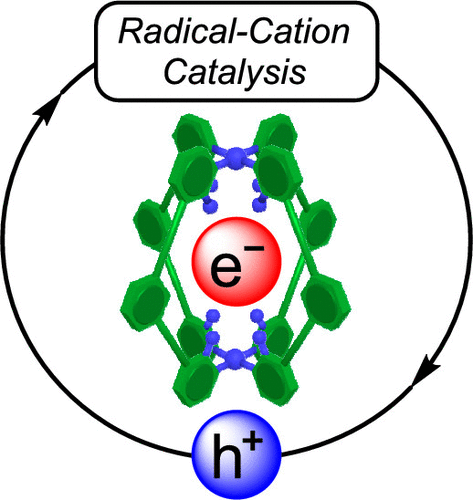当前位置:
X-MOL 学术
›
J. Am. Chem. Soc.
›
论文详情
Our official English website, www.x-mol.net, welcomes your feedback! (Note: you will need to create a separate account there.)
Host-Guest Induced Electron Transfer Triggers Radical-Cation Catalysis
Journal of the American Chemical Society ( IF 15.0 ) Pub Date : 2020-01-14 , DOI: 10.1021/jacs.9b11273 Rebecca L Spicer 1 , Athanasios D Stergiou 2 , Tom A Young 3 , Fernanda Duarte 3 , Mark D Symes 2 , Paul J Lusby 1
Journal of the American Chemical Society ( IF 15.0 ) Pub Date : 2020-01-14 , DOI: 10.1021/jacs.9b11273 Rebecca L Spicer 1 , Athanasios D Stergiou 2 , Tom A Young 3 , Fernanda Duarte 3 , Mark D Symes 2 , Paul J Lusby 1
Affiliation

|
Modifying the reactivity of substrates by encapsulation is a fundamental principle of capsule catalysis. Here we show an alternative strategy, wherein catalytic activation of otherwise inactive quinone "co-factors" by a simple Pd2L4 capsule pro-motes a range of bulk-phase, radical-cation cycloadditions. Solution electron transfer experiments and cyclic voltammetry show the cage anodically shifts the redox potential of the encapsulated quinone by a significant 1 V. Moreover, the capsule also protects the reduced semiquinone from protonation, thus transforming the role of quinones from stoichiometric oxidants into catalytic single electron acceptors. We envisage that the host-guest induced release of an "electron hole" will translate to various forms of non-encapsulated catalysis that involve other difficult to handle, highly reactive species.
中文翻译:

主客体诱导的电子转移触发自由基阳离子催化
通过封装改变底物的反应性是胶囊催化的基本原理。在这里,我们展示了一种替代策略,其中通过简单的 Pd2L4 胶囊催化活化原本不活跃的醌“辅因子”,促进了一系列本体相、自由基阳离子环加成。溶液电子转移实验和循环伏安法显示笼子使封装的醌的氧化还原电位阳极移动了 1 V。此外,胶囊还保护还原的半醌免受质子化,从而将醌的作用从化学计量氧化剂转化为催化单电子接受者。我们设想主客体诱导的“电子空穴”释放将转化为各种形式的非封装催化,涉及其他难以处理的,
更新日期:2020-01-14
中文翻译:

主客体诱导的电子转移触发自由基阳离子催化
通过封装改变底物的反应性是胶囊催化的基本原理。在这里,我们展示了一种替代策略,其中通过简单的 Pd2L4 胶囊催化活化原本不活跃的醌“辅因子”,促进了一系列本体相、自由基阳离子环加成。溶液电子转移实验和循环伏安法显示笼子使封装的醌的氧化还原电位阳极移动了 1 V。此外,胶囊还保护还原的半醌免受质子化,从而将醌的作用从化学计量氧化剂转化为催化单电子接受者。我们设想主客体诱导的“电子空穴”释放将转化为各种形式的非封装催化,涉及其他难以处理的,


























 京公网安备 11010802027423号
京公网安备 11010802027423号